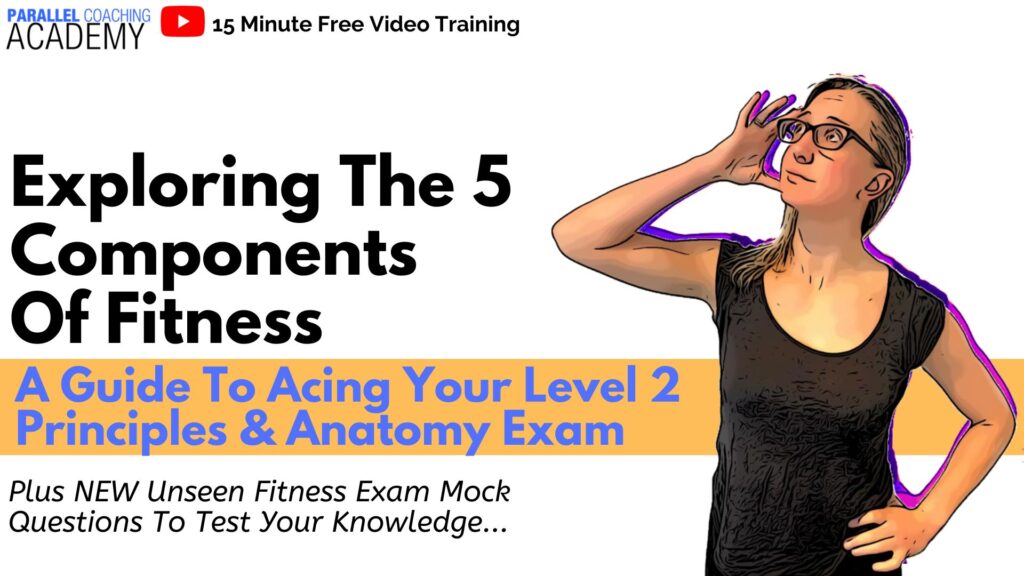Welcome to today’s blog, where we delve into the 5 components of fitness, a Guide To ace your Level 2 Principles & Anatomy Exam. Today’s blog includes
- A 15-minute tutorial on the 5 Components of Fitness
- Why you need to know the different categories of fitness
- Differentiation between exercise, physical activity, and physical fitness
- The 5 Health-Related Components of Fitness
- The Skill-Related Components
- and Three mock questions testing knowledge
Start by watching the 15-minute tutorial, where we’ll unravel the intricacies of the 5 Components of Fitness, essential knowledge for any dedicated FITPRO.
Watch: 15-minute Tutorial – The components of fitness
Why you need to learn the 5 Components of Fitness
As a FITPRO you will need to understand all components of fitness to ensure that you are creating well-rounded, balanced, and effective programs for your clients.
A client who is missing out on key components of fitness may be more susceptible to injury and overtraining.
They may also be missing out on health benefits associated with other components of fitness, which could restrict them from achieving their full potential.
The combination of your anatomy and physiology knowledge and that of core principles of fitness will allow you to get the best results possible with your clients.
Exercise and Physical Fitness Are Different
Exercise is defined as: ‘Structured or planned activity that requires physical effort, with the aim of sustaining or improving physical fitness‘
WHO defines physical activity as ‘any bodily movement produced by skeletal muscles that requires energy expenditure‘
This is different for Physical Fitness, which is defined as ‘A state of well-being that provides optimal performance“
Physical fitness is a potential outcome of taking part in regular physical activity and exercise.
Being physically fit defines an individual’s ability to perform activities or exercises that train different components of fitness.
The Health-Related Components Of Fitness
- Cardiovascular (CV) Fitness – The ability of the heart, lungs, and muscles to take in, transport, and utilise oxygen during exercise…. aka, Cardiovascular fitness, stamina and aerobic fitness
- Muscular Endurance – The ability of the muscles to work continuously under low-to-moderate resistance
- Muscular Strength -The ability of the muscles to exert maximal force against a high resistance
- Flexibility – The ability of a joint and the muscles that cross it to have an optimal and efficient range of movement
- Body Composition – Defined as the % proportion of fat mass VS muscle mass
Exploring Body Composition in more depth
Two individuals may be of equal weight and height, but their body composition and appearance may be totally different.
Muscular tissue takes up less space in the body than fat tissue and this influences how lean a person appears. Remember, a ton of bricks VS a tonne of feathers weigh the same yet occupy different size spaces.
Health body fats are considered to be:
- Women = 21 – 36%
- Men = 8 – 25%
Skill-Related Components Of Fitness
Use the Acronym SPACER to remember the skill-related components
- Speed – How quickly a movement can be performed
- Power – To exert maximum muscular contraction instantly in an explosive burst of movement
- Agility – The ability to change the position of the body and move in different directions quickly
- Coordination – The ability to smoothly move two or more parts of the body under control
- Equilibrium / Balance – The ability to control the body’s centre of gravity
- Reaction Time – The ability to respond quickly to a stimulus
Now you’ve learned about the 5 Components of Fitness, test your knowledge with these 3 mock questions
Test your knowledge with today’s mock questions:
[NOTE: The answers are below the 3rd question]
Q1: Which of the following is NOT classed as a component of health-related fitness?
A. Power
B. Muscular Strength
C. Cardiovascular
D. Body Composition
Q2: What is considered to be a healthy Body Fat percentage for a female?
A. 30-60%
B. 5 – 15%
C. 21 – 36%
D. 8 – 25%
Q3: Which of the following is a Skill Related Component of Fitness?
A. Flexibility
B. Reaction Times
C. Body Composition
D. Cardiovascular
Answers to the mock questions are :
Question 1= A, Question 2 = C, Question 3 = B
If you want more mock questions like this, then you can download more Free Mock Questions: DOWNLOAD NOW
Need More Help with your Level 2 Anatomy Revision?
For Trainee FITPROS Taking Their L2 Anatomy & Physiology Exam.
Learn, Revise & Pass Your Level 2 Anatomy & Physiology Exam In Under 10-hours
(Without Having To Spend Hours Revising Or Feeling Overwhelmed)
If you want to get your revision structured, learn everything you need to know, and feel confident on exam day, then click the link below:

Dedicated to More
Hayley “Exploring The 5 Components of Fitness” Bergman
Parallel Coaching
P.S. You can also find us on the following platforms:
Instagram: Follow Now
Facebook: Like Our Page
Twitter: Tweet Us
YouTube: Subscribe Here
More L2 Anatomy Revision Blogs: HERE
More coursework help HERE

